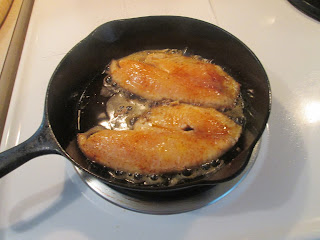Wow, July ending on a cool week around here. It might be about 74 degrees if that, but I'm not complaining. I love the days of 70 degree weather, just wish the sun was out. Fired the grill up for everyone I was grilling a Pork Chop and I grilled a couple of Burgers for Mom and Dad. For dinner I prepared a Grilled Pork Chop w/ Mashed Potatoes, Green Beans, and Whole Grain Bread.
I just seasoned it with Sea Salt and Ground Black Pepper. Grilled it about 4 1/2 - 5 minutes per side. As I took it off the grill I basted one side with some of my favorite BBQ Sauce, JB's Fat Boy Haug Waush BBQ Sauce. JB's is my choice of Rubs and Sauces, I just don't think the taste can be beat! The Chop came out with grill char and it was moist and tender.
For side dishes I prepared some bob Evan's Mashed Potatoes. Just heat in the microwave and serve. I also warmed a small can of Del Monte Cut Green Beans along with a couple of slices of Healthy Life Whole Grain Bread. For dessert later a bowl of Del Monte No Sugar Added Peach Chunks.
From the Pork Be Inspired web site, http://www.porkbeinspired.com/index.aspx
Meat Thermometer How To
Because pork can often be overcooked, checking the internal temperature often will help prevent dry pork. Cook pork until the internal temperature reaches 145 degrees Fahrenheit, followed by a three-minute rest time, and is a little pink inside. A digital, instant-read thermometer is a low-cost, must-have for every kitchen. When inserted into the thickest part of the meat (without touching any bone), the temperature should register within a few seconds. Instant-read thermometers are not meant to be left in the meat during cooking. If you wish to invest a bit more, continuous-read digital thermometers are another option. Designed to be left in the meat during the entire duration of cooking, they often include a probe that is placed in the meat. The probe is connected via cord to the thermometer unit, which can be placed on a countertop near the stove. - See more at:
http://www.porkbeinspired.com/Basics_MeatThermometerHowTo.aspx#sthash.ejfqNdOr.dpuf
Nutritional Information
Today’s Pork Leaner Than Ever
A Study released in 2006 by the USDA reveals six common cuts of fresh pork are leaner today than they were fifteen years ago.
Power Up With Pork
Purdue Weight Loss Study
Pork and Health Science Update
Frequently Asked Questions: Pork And The AICR/WCRF Second Expert Report
MyPyramid Food Guidance System
The MyPyramid food guidance system for Americans emphasizes the importance of finding a balance between food and physical activity. Lean pork can enhance and easily fit into a balanced diet.
Vitamins and Minerals in Pork
Daily Values are listed on food labels. They tell us how much of various nutrients we should consume each day. The following information is based on a 3-ounce serving of pork. As you can see, pork is an important source of many key nutrients.
Fat in Pork
Through changes in feeding and breeding techniques, pork producers have responded to consumer demand for leaner pork. Today’s common cuts of pork are 16% leaner and has 27% less saturated fat as compared to 1991. Many cuts of pork are as lean as skinless chicken.
How does pork compare to other meats for fat, calories and cholesterol? Pork today compares favorably for fat, calories and cholesterol with many other meats and poultry. While providing a greater amount of vitamins and minerals, many cuts of pork are as lean or leaner than chicken. Pork tenderloin, for example, is just as lean as skinless chicken breast and meets the government guidelines for “extra lean.” In total, six pork cuts meet the USDA guidelines for “lean,” with less than 10 grams fat, 4.5 grams saturated fat and 95 milligrams of cholesterol per serving. Any cuts from the loin - like pork chops and pork roast - are leaner than skinless chicken thigh, according to USDA data. Pork steaks or roasts from the leg ("fresh ham") are also lean choices.
- See more at: http://www.porkbeinspired.com/NutritionalInfo_NutritionalInformation.aspx#sthash.Pg8kSbmR.dpuf







+is+a+species+of+marine+flatfish+widely+found+around+the+coasts+of+Europe.jpg)























